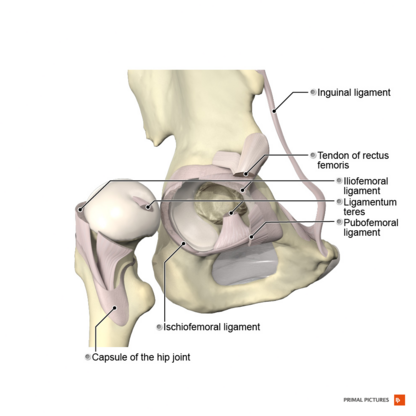Ischiofemoral Ligament
Original Editor - Mohit Chand
Top Contributors - Mohit Chand
Introduction[edit | edit source]
The hip joint is reinforced by three primary fibrous capsular ligaments, including the ischiofemoral ligament, which plays a crucial role in stabilizing the joint. [1]This ligament, along with the iliofemoral and pubofemoral ligaments, contributes to the overall stability and function of the hip joint.
Attachments[edit | edit source]
- The ischiofemoral ligament originates from the ischium at a point below and behind the acetabulum and attaches to the intertrochanteric line of the femur.
- It attaches to the posterior surface of the acetabular rim and acetabular labrum, extending around the circumference of the joint to insert on the anterior aspect of the femur.
Here is a video to explain the major ligaments of hip joint clearly.
Function[edit | edit source]
The ischiofemoral ligament restricts internal rotation of the hip joint, particularly in relation to hip flexion angles. Studies have shown that this ligament, along with the iliofemoral ligament, plays a significant role in preventing excessive internal hip rotation and maintaining joint stability.[3]
Clinical Relevance[edit | edit source]
Injuries to the ischiofemoral ligament can occur in dislocations, leading to lesions of the foveal artery and potentially resulting in osteonecrosis of the femoral head. The ligament is also associated with conditions like hip joint effusion, fractures, dislocations, ischiofemoral impingement syndrome and congenital dislocation of the hip, highlighting its clinical relevance in hip pathologies.[4]
References[edit | edit source]
- ↑ Geoffrey Ng, K. C., R. T. Jeffers, and Paul E. Beaulé. "Hip Joint Capsular Anatomy, Mechanics, and Surgical Management." The Journal of Bone and Joint Surgery. American Volume 101, no. 23 (2019): 2141-2151. Accessed March 30, 2024.
- ↑ Sport Science Solutions . Ligaments of the Hip. Available from: https://www.youtube.com/watch?v=zyqiRs4MnzA[last accessed 30/3/2024]
- ↑ Baba, Kazuyoshi, Yu Mori, Daisuke Chiba, Yoshiyuki Kuwahara, Hiroaki Kurishima, Hidetatsu Tanaka, Atsushi Kogure et al. "TiNbSn Stems with Gradient Changes of Young’S Modulus and Stiffness Reduce Stress Shielding Compared to the Standard Fit-and-fill Stems." European Journal of Medical Research 28, (2023). Accessed March 30, 2024..
- ↑ Moore, K. L., Dalley, A. F. and Agur, A. M. R. (2013) Clinically Oriented Anatomy. Clinically Oriented Anatomy 7th edn.: Wolters Kluwer Health/Lippincott Williams & Wilkins. Standring, S. (2016) Gray's Anatomy: The Anatomical Basis of Clinical Practice. Gray's Anatomy Series 41st edn.: Elsevier Limited.







